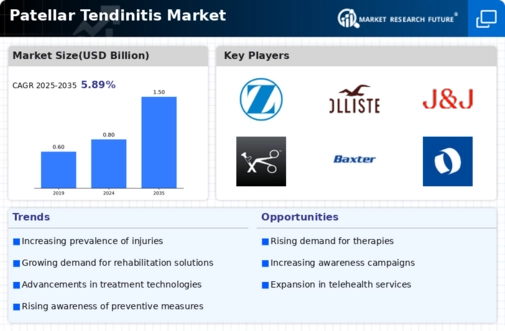Market Growth Projections
The Global Patellar Tendinitis Market Industry is poised for substantial growth, with projections indicating an increase from 0.8 USD Billion in 2024 to 1.5 USD Billion by 2035. This growth trajectory suggests a compound annual growth rate (CAGR) of 5.88% from 2025 to 2035. The anticipated expansion is driven by various factors, including rising prevalence rates, advancements in treatment modalities, and increased awareness of the condition. As the market evolves, stakeholders are likely to focus on developing innovative solutions to address the needs of patients suffering from patellar tendinitis, ultimately enhancing the overall landscape of care.
Growing Awareness and Education
Increased awareness and education regarding patellar tendinitis are driving the Global Patellar Tendinitis Market Industry. Healthcare professionals and sports organizations are emphasizing the importance of recognizing early symptoms and seeking timely intervention. Educational campaigns aimed at athletes and coaches are fostering a better understanding of injury prevention strategies, thereby reducing the incidence of patellar tendinitis. This heightened awareness is likely to lead to an increase in consultations and treatment-seeking behavior, contributing to market growth. As more individuals become informed about the condition, the demand for specialized care and rehabilitation services is expected to rise.
Advancements in Treatment Modalities
Innovations in treatment modalities are significantly influencing the Global Patellar Tendinitis Market Industry. The introduction of advanced therapies, such as regenerative medicine techniques, including platelet-rich plasma (PRP) injections and stem cell therapy, offers promising outcomes for patients. These treatments aim to enhance healing and reduce recovery time, appealing to both athletes and recreational sports enthusiasts. As these advanced therapies gain traction, the market is expected to expand, with projections indicating a growth to 1.5 USD Billion by 2035. This evolution in treatment options may lead to increased patient satisfaction and improved quality of life for those affected by patellar tendinitis.
Rising Prevalence of Patellar Tendinitis
The Global Patellar Tendinitis Market Industry is experiencing growth due to the increasing prevalence of patellar tendinitis among athletes and active individuals. Factors such as high-impact sports, repetitive strain, and inadequate warm-up routines contribute to the condition's rise. In 2024, the market is valued at approximately 0.8 USD Billion, reflecting the growing awareness and diagnosis of this condition. As more individuals engage in sports and physical activities, the demand for effective treatment options and rehabilitation services is likely to increase, further propelling market growth. This trend suggests a sustained focus on preventive measures and therapeutic interventions.
Expansion of Sports and Fitness Activities
The expansion of sports and fitness activities globally is a key driver of the Global Patellar Tendinitis Market Industry. As more individuals engage in various physical activities, the likelihood of developing patellar tendinitis increases. This trend is particularly evident in regions where sports participation is on the rise, such as Asia-Pacific and North America. The growing popularity of fitness programs and recreational sports is likely to result in a higher incidence of overuse injuries, including patellar tendinitis. Consequently, the market is projected to grow at a compound annual growth rate (CAGR) of 5.88% from 2025 to 2035, reflecting the increasing need for effective treatment solutions.
Technological Integration in Rehabilitation
Technological advancements in rehabilitation are shaping the Global Patellar Tendinitis Market Industry. The integration of digital health solutions, such as telemedicine and mobile health applications, is enhancing patient access to care and facilitating remote monitoring of rehabilitation progress. These technologies allow healthcare providers to offer personalized treatment plans and track recovery outcomes effectively. As patients increasingly seek convenient and efficient rehabilitation options, the demand for technology-driven solutions is likely to rise. This trend may contribute to the overall growth of the market, as more individuals seek innovative approaches to manage and recover from patellar tendinitis.














